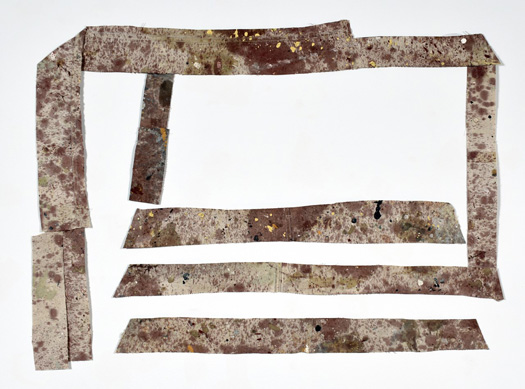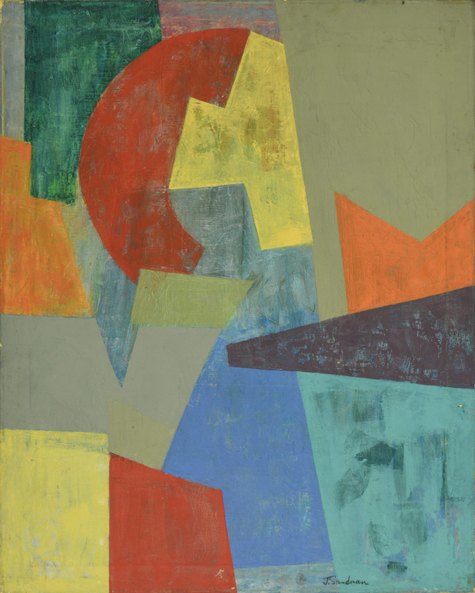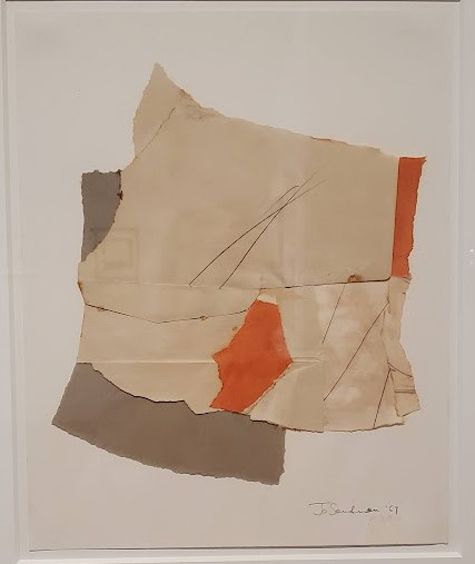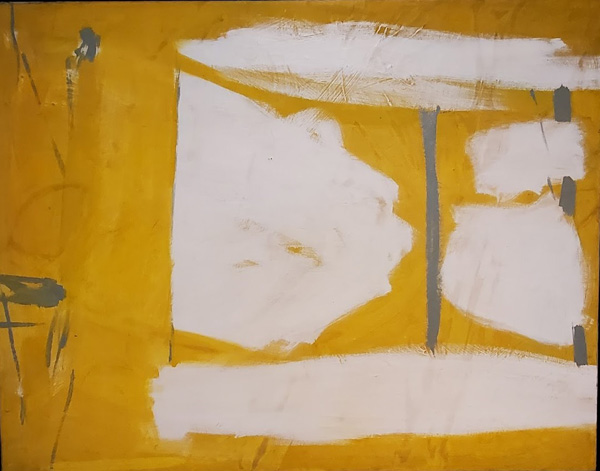Review: Jo Sandman
Daniel Barbiero
September 2022
Jo Sandman at Black Mountain College Museum, Asheville NC
 Tarp Series (Glyph), 1983. Collage, found painter’s dropcloth.
Tarp Series (Glyph), 1983. Collage, found painter’s dropcloth.
All images courtesy of the Black Mountain College Museum + Arts Center.
For Massachusetts artist Jo Sandman (b 1931), a summer spent at Black Mountain College led to a lifetime commitment to making art. Traces, a survey of her decades-long career was the featured exhibit at the Black Mountain College Museum in downtown Asheville, which I happened to see while visiting the city last month.
Sandman was at Black Mountain for the summer 1951 session, as part of a class that included Robert Rauschenberg and Cy Twombly. Sandman studied painting, drawing, and photography, as well as anthropology and French. Her teachers included Robert Motherwell and Ben Shahn (painting); Joseph Fiore (drawing); and Harry Callahan and Aaron Siskind (photography). The session was life-changing; it convinced her to dedicate herself to making art. After her time at Black Mountain she continued studying with Motherwell and went on to study with Hans Hofmann as well, after having obtained an undergraduate degree from Brandeis University in 1952, and in 1954 went on to obtain an MFA from the University of California at Berkeley.
 Untitled, n.d. Oil on canvas
Untitled, n.d. Oil on canvas
The museum presented a generous cross-section of Sandman’s work throughout the years, even given the relatively small extent of its exhibition space. The period from 1951 to about 1960 was covered by a handful of abstract paintings. An early, untitled painting made up of contrasting colors contained within cubes, triangles and a curve may have been done at Black Mountain College; its hints of cubism may be a reflection of Shahn’s teaching. A 1952 abstraction features rectangular blocks of color drawn from a mostly dark palette punctuated by reds, yellows, and oranges. The gestural painting Clichy, executed around 1960, places thickly brushed on strokes of white and thin gray lines against a yellow background.
Post-1960, painting gives way to works made of a wide variety materials. During the 1960s, Sandman worked with collage. An untitled example from 1967 is made up of large pieces of torn paper in subdued colors set off by two smaller pieces of orange. In the 1970s she produced soft sculptures made of folded textiles. The 1973 Grid, of Belgian linen is, as its title indicates, folded into a grid of rectangles laid out in twelve rows and three columns. Her work with soft materials continued into the 1980s in a series of collages made of strips cut from paint-speckled tarps. In the 1990s she was creating the Continuities series, a set of black and white sculptures made of sections of bent radiator hoses and plaster, the result of a serendipitous moment in a mechanic’s garage while she waited for her car to be repaired. Her work post-2000 is particularly eclectic and includes photography, burnt paper sculpture, thermal drawings made on fax paper, and multimedia works based on found objects.
 Untitled collage, 1967
Untitled collage, 1967
The works give evidence of an artist who was not content to choose one means or method of expression and stay with it forever. The challenge is to find an element that draws these works together. In spite of the obvious diversity that marks her output, there does seem to be a formal continuity that runs through much of it, at least up until the turn of the millennium–a tendency toward abstraction, often embodied in structures defined by a certain angularity and not infrequently made up of perpendiculars, whether in the form of grids or rectangular geometric shapes. We can see it in the earliest abstract paintings of the 1950s, in the narrow strips of the Tarp series, in the open squares of the tar drawings, in the layout of the painted-over gestures in Clichy, in the folded patters of the textile sculptures, and even in softened form in the sculptures made of bent radiator hoses. After 2000, abstraction takes a different shape as Sandman tempers it with a certain realism of subject matter, particularly as seen in a series of digitally enhanced x-ray photographs. Although they depict identifiable parts of the skeleton, they’re presented in a way that emphasizes the formal qualities of the images, an emphasis brought out in an almost painterly arrangement of light and dark spaces.
 Clichy, n.d. Oil on canvas
Clichy, n.d. Oil on canvas
Formal considerations aside, the real thread of continuity tying these different works together may be Sandman’s constantly evolving ability to see creative potential in whatever happened to be at hand, whether industrial materials, castoff dropcloths, automotive parts, medical x-rays, stones picked up from the beach, or colored paper. Taken as a whole, her corpus shows how a singular focus on artmaking can manifest itself in a multiplicity of methods and materials.
Jo Sandman / TRACES
Black Mountain College Museum + Arts Center
June 3, 2022 – September 3, 2022
Daniel Barbiero is a double bassist, composer and writer in the Washington DC area. He writes on the art, music and literature of the classic avant-gardes of the 20th century and on contemporary work, and is the author of the essay collection As Within, So Without (Arteidolia Press, 2021).
